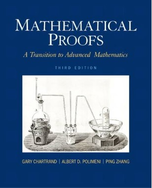Let A = (0, 1) be the open interval of real numbers between 0 and 1. For each number r
Chapter 10, Problem 10.45(choose chapter or problem)
Let A = (0, 1) be the open interval of real numbers between 0 and 1. For each number r A, let0.r1r2r3 ... denote its unique decimal expansion in which no expansion has the digit 9 from some point on.For (a, b) A A, letf ((a, b)) = f ((0.a1a2a3 ..., 0.b1b2b3 ...)) = 0.a1b1a2b2 ... ;while for a A, letg(a) = g(0.a1a2a3 ...) = (0.a1a3a5 ..., 0.a2a4a6 ...).With the aid of f and g, which of the following are we able to conclude? Explain your answer.(a) |A A||A|.(b) |A||A A|.(c) |A A|=|A|.(d) Nothing because neither f : A A A nor g : A A A is a function.(e) Nothing because both f : A A A and g : A A A are functions but neither is injective.(f) Nothing, for a reason other than those given in (d) and (e).
Unfortunately, we don't have that question answered yet. But you can get it answered in just 5 hours by Logging in or Becoming a subscriber.
Becoming a subscriber
Or look for another answer
